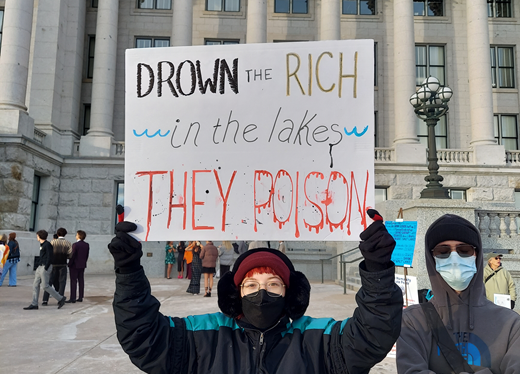Saving the Great Salt Lake
- thelineinfo

- Jan 21, 2024
- 4 min read
Updated: Jan 24, 2024
Article and Images by Jacob Rueda

Hundreds of people gathered for a rally at the Utah State Capitol on Saturday January 20th to address issues surrounding the Great Salt Lake. Since 2002, the year Salt Lake City hosted the Winter Olympics, the lake's size has not returned to that of previous years. A Google Earth time lapse shows satellite images of the lake fluctuating in size before starting to become smaller in 2003.
While some rally-goers held signs, others came dressed as wildlife from the lake. During the rally, there were speeches, songs, and chants. With the state legislature in session until the end of the month, the aim of the rally was to get lawmakers' attention and pass bills that would help save the lake.

AGRICULTURAL WATER USE
One of the biggest issues surrounding the lake is how much water is deviated from sources and used for agriculture, primarily, alfalfa and hay farming. Part of solving the problems facing the lake is addressing agricultural water use.
"Agricultural water use represents about two thirds of consumptive water use from the Great Salt Lake Basin," said Katie Newburn, an education and Outreach Director for Friends of Great Salt Lake who tabled at the state capitol rally.
Growing alfalfa requires using a lot of water. According to a November 2022 Salt Lake Tribune article, it takes 450,000 gallons to produce one ton of alfalfa. Newburn said that amount of water consumption provides an opportunity to look at conservation efforts.
"What the state has been doing over the last few years is investing millions of dollars in agricultural water optimization," she said, "Which are providing essentially subsidies funding programs for farmers to implement more water efficient technology to still produce crops, still have their livelihood, but use less water in the process."
WATER RIGHTS
Water for the Great Salt Lake comes from different sources but mainly from the Wasatch and Uinta Mountains. Along the way, water that would go to the lake is diverted from rivers and streams and fed into agriculture and businesses who have rights to those water sources.
Once those water rights are retained, they're almost never given up. As a result, it makes it difficult to not only address water conservation, but to get more water to flow into the Great Salt Lake.
"The water rights issue is tricky," said Jonny Vasic, executive director of Utah Physicians for Healthy Environment, one of the organizers of the rally at the state capitol.
"We have some late 1800 Homesteader Act that once you have water rights, you have 'em forever," he said, "We used to have a 'use it or lose it,' which was revised last year, but we need to get some of the water rights and permanently push them to the Great Salt Lake."
Vasic said revisions were needed in the acts and what the rights were in those acts so the lake can receive more water.
"Many of the areas around the lake are either farmer owned, duck clubs own a lot of water rights," he said, "[The Church of Jesus Christ of Latter-Day Saints] recently gave up some of their water rights for the lake, but it's such a minuscule amount. We need a massive amount of water over many, many years to get the lake healthy again."

PUBLIC AND LEGISLATIVE SUPPORT FOR THE LAKE
Rep. Doug Owens, a Democrat representing Utah's 33rd District, introduced legislation in the past and in the current session addressing the needs of the Great Salt Lake. Vasic said he feels good about Owen's work in the legislature regarding the lake and that more needs to be done to help save it.
"He's good and switched on to the fact that we gotta get water into the lake and simply studying it more is not enough," he said, "We know the issues. So now we need the will, we need the political will to do what's necessary."
Newburn with the Friends of Great Salt Lake said some legislative progress had been made in 2022 with regard to revisions to water rights policies.
"The state has started to reform those policies in a really necessary way to make progress for Great Salt Lake House Bill 33," she said, "It allowed state agencies to acquire, lease, hold water rights on behalf of lands that they are managing, including the Great Salt Lake. And that was a huge barrier that was eliminated and has allowed us to now work toward acquiring enough water to support the lake."
Despite all that's been done, progress still needs to be made to return water levels at the Great Salt Lake to where they were before the 2002 Winter Olympics. With more attention given to the situation through media and rallies, the public is becoming more informed on the issue.
"I know that it's been something that I've heard about," said Martin Torres, a Utah native and one of the rally attendants. He also said the rally was informative and had community to feel, which will help him take action in the future.
"Definitely being more active, but then also just learning a lot more about what has been passed, what has been talked about," he said.



















Comments